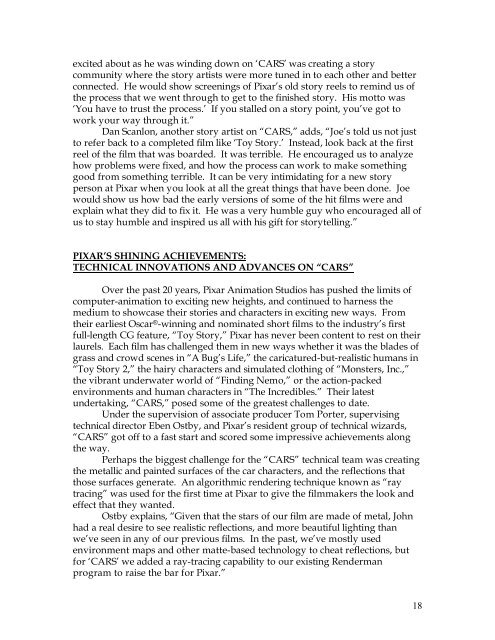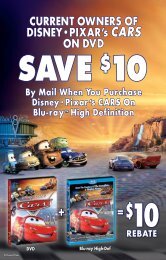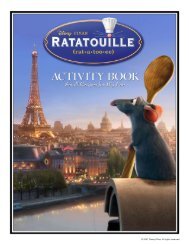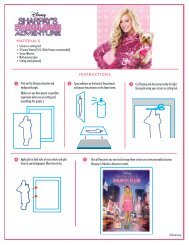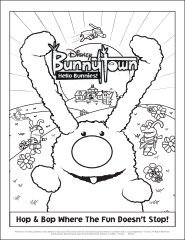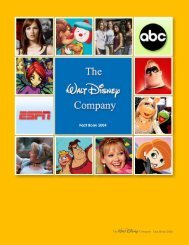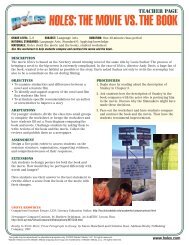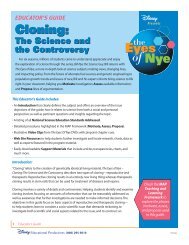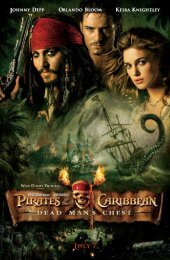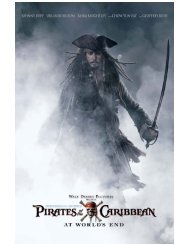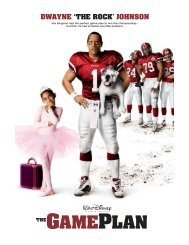1 CARS PRODUCTION INFORMATION After taking ... - Disney
1 CARS PRODUCTION INFORMATION After taking ... - Disney
1 CARS PRODUCTION INFORMATION After taking ... - Disney
You also want an ePaper? Increase the reach of your titles
YUMPU automatically turns print PDFs into web optimized ePapers that Google loves.
excited about as he was winding down on ‘<strong>CARS</strong>’ was creating a story<br />
community where the story artists were more tuned in to each other and better<br />
connected. He would show screenings of Pixar’s old story reels to remind us of<br />
the process that we went through to get to the finished story. His motto was<br />
‘You have to trust the process.’ If you stalled on a story point, you’ve got to<br />
work your way through it.”<br />
Dan Scanlon, another story artist on “<strong>CARS</strong>,” adds, “Joe’s told us not just<br />
to refer back to a completed film like ‘Toy Story.’ Instead, look back at the first<br />
reel of the film that was boarded. It was terrible. He encouraged us to analyze<br />
how problems were fixed, and how the process can work to make something<br />
good from something terrible. It can be very intimidating for a new story<br />
person at Pixar when you look at all the great things that have been done. Joe<br />
would show us how bad the early versions of some of the hit films were and<br />
explain what they did to fix it. He was a very humble guy who encouraged all of<br />
us to stay humble and inspired us all with his gift for storytelling.”<br />
PIXAR’S SHINING ACHIEVEMENTS:<br />
TECHNICAL INNOVATIONS AND ADVANCES ON “<strong>CARS</strong>”<br />
Over the past 20 years, Pixar Animation Studios has pushed the limits of<br />
computer-animation to exciting new heights, and continued to harness the<br />
medium to showcase their stories and characters in exciting new ways. From<br />
their earliest Oscar ® -winning and nominated short films to the industry’s first<br />
full-length CG feature, “Toy Story,” Pixar has never been content to rest on their<br />
laurels. Each film has challenged them in new ways whether it was the blades of<br />
grass and crowd scenes in “A Bug’s Life,” the caricatured-but-realistic humans in<br />
“Toy Story 2,” the hairy characters and simulated clothing of “Monsters, Inc.,”<br />
the vibrant underwater world of “Finding Nemo,” or the action-packed<br />
environments and human characters in “The Incredibles.” Their latest<br />
under<strong>taking</strong>, “<strong>CARS</strong>,” posed some of the greatest challenges to date.<br />
Under the supervision of associate producer Tom Porter, supervising<br />
technical director Eben Ostby, and Pixar’s resident group of technical wizards,<br />
“<strong>CARS</strong>” got off to a fast start and scored some impressive achievements along<br />
the way.<br />
Perhaps the biggest challenge for the “<strong>CARS</strong>” technical team was creating<br />
the metallic and painted surfaces of the car characters, and the reflections that<br />
those surfaces generate. An algorithmic rendering technique known as “ray<br />
tracing” was used for the first time at Pixar to give the filmmakers the look and<br />
effect that they wanted.<br />
Ostby explains, “Given that the stars of our film are made of metal, John<br />
had a real desire to see realistic reflections, and more beautiful lighting than<br />
we’ve seen in any of our previous films. In the past, we’ve mostly used<br />
environment maps and other matte-based technology to cheat reflections, but<br />
for ‘<strong>CARS</strong>’ we added a ray-tracing capability to our existing Renderman<br />
program to raise the bar for Pixar.”<br />
18


